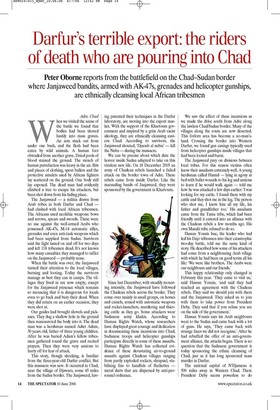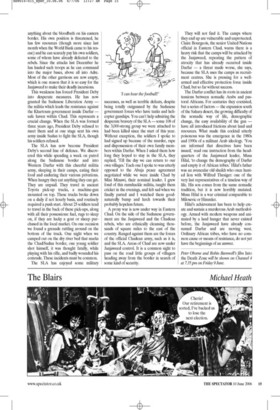Darfur’s terrible export: the riders of death who are pouring into Chad
Peter Oborne reports from the battlefield on the Chad–Sudan border where Janjaweed bandits, armed with AK-47s, grenades and helicopter gunships, are ethnically cleansing local African tribesmen
Adre, Chad
When we visited the scene of the battle we found that bodies had been shoved hastily into mass graves. An arm stuck out from under one bush, and the flesh had been eaten by wild animals. A human foot obtruded from another grave. Dried pools of blood stained the ground. The stench of human putrefaction was heavy in the air. Bits and pieces of clothing, spent bullets and the protective amulets used by African fighters lay scattered on the ground. One body still lay exposed. The dead man had evidently climbed a tree to escape his attackers, but been shot down from his hiding place.
The Janjaweed — a militia drawn from Arab tribes in both Darfur and Chad had clashed with local African tribesmen. The Africans used neolithic weapons: bows and arrows, spears and swords. These were no use against the well-armed Arabs who possessed AK-47s, M-14 automatic rifles, grenades and even anti-tank weapons which had been supplied from Sudan. Survivors said the fight lasted on and off for two days and left 118 tribesmen dead. It’s not known how many casualties they managed to inflict on the Janjaweed — probably none.
When the battle was over, the Janjaweed turned their attention to the local villages, burning and looting. Today the survivors manage as best they can in camps. The villages they lived in are now empty, except for the Janjaweed presence which remains so menacing that it is dangerous for locals even to go back and bury their dead. When they did return on an earlier occasion, they were shot at.
Our guides had brought shovels and pickaxes. They dug a shallow hole in the ground then manoeuvred the body into it. The dead man was a herdsman named Adiet Adam, 30 years old, father of three young children. After he was buried Adam’s fellow tribesmen gathered round the grave and recited prayers. Then they were very anxious to hurry off for fear of attack.
This story, though shocking, is familiar from the three-year-old Darfur conflict. But this massacre was new. It occurred in Chad, near the village of Djawara, some 45 miles from the Sudan border. The Janjaweed, hav ing patented their techniques in the Darfur laboratory, are moving into the export market. With the support of the Khartoum government and inspired by a grim Arab racist ideology, they are ethnically cleansing eastern Chad. According to survivors, the Janjaweed shouted, ‘Djaoub al nubia’ — kill the Nuba — during the massacre.
We can be precise about which date the horror inside Sudan adapted to take on this virulent new life. On 18 December 2005 an army of Chadean rebels launched a failed attack on the border town of Adre. These rebels came from inside Darfur. Like the marauding bands of Janjaweed, they were sponsored by the government in Khartoum.
Since last December, with steadily mounting intensity, the Janjaweed have followed the Chadean rebels across the border. They come over mainly in small groups, on horses and camels, armed with automatic weapons and rocket-launchers, murdering and thieving cattle as they go. Some attackers wear Sudanese army khakis. According to Human Rights Watch, whose researchers have displayed great courage and dedication in documenting these incursions into Chad, Sudanese troops and helicopter gunships participate directly in some of these assaults. Human Rights Watch has collected evidence of these devastating air-to-ground assaults against Chadean villages ranging from partly exploded rockets, shrapnel, stabilising fins to handfuls of flechettes metal darts that are dispersed by anti-personnel ordnance. We saw the effect of these incursions as we made the drive south from Adre along the lawless Chad/Sudan border. Many of the villages along the route are now deserted. This forlorn area has become a no-man’sland. Crossing the border into Western Darfur, we found gun casings typically used from helicopter gunships inside villages that had been looted and burnt.
The Janjaweed prey on divisions between local tribes. For this reason victims often know their assailants extremely well. A young herdsman called Hamid — lying in agony in bed with bullet wounds to his leg and anxious to learn if he would walk again — told me how he was attacked a few days earlier: ‘I was looking for my cattle. I found them with my cattle and they shot me in the leg. The person who shot me, I know him all my life, his father and grandfather too.’ His assailants came from the Tama tribe, which had been friendly until it entered into an alliance with the Chadean rebels a few months ago. His own Masalit tribe refused to do so.
Hassan Younis Isac, the leader who had led his Dajo tribesmen into their catastrophic two-day battle, told me the same kind of story. He described how some of his attackers had come from a neighbouring Arab village with which he had been on good terms all his life: ‘We were like brothers. The Arabs were our neighbours and our friends.’ This happy relationship only changed in February this year. ‘They came to visit us,’ said Hassan Younis, ‘and said they had reached an agreement with the Chadean rebels. They said we should join with them and the Janjaweed. They asked us to join with them to take power from President Deby. They said that if you refuse you are on the side of the government.’ Hassan Younis says his Arab neighbours went to the Sudan and came back with a lot of guns. He says, ‘They came back with strange faces we did not recognise.’ After he had rebuffed the offer of an anti-government alliance, the attacks began. There is no question that the Sudanese government is today sponsoring the ethnic cleansing of Chad, just as it has long sponsored mass murder in Darfur.
The national capital of N’Djamena is 500 miles away in Western Chad. There President Deby seems powerless to do anything about the bloodbath on his eastern border. His own position is threatened, he has few resources (though more since last month when the World Bank came to his rescue) and he can scarcely pay his own soldiers, some of whom have already defected to the rebels. Since the attacks last December he has hauled such troops as he can command into the major bases, above all into Adre. Most of the other garrisons are now empty, which is one reason that it is so easy for the Janjaweed to make their deadly incursions.
This weakness has forced President Deby into desperate measures. He has now granted the Sudanese Liberation Army the militia which leads the resistance against the Khartoum government inside Darfur safe haven within Chad. This represents a crucial change. When the SLA was formed three years ago, President Deby refused to meet them and at one stage sent his own army inside Sudan to fight the SLA, though his soldiers refused.
The SLA has now become President Deby’s second line of defence. We discovered this while spending a week on patrol along the Sudanese border and into Western Darfur with this cheerful militia army, sleeping in their camps, eating their food and enduring their various privations. When hungry they eat anything they can get. They are unpaid. They travel in ancient Toyota pick-up trucks, a machine-gun mounted on top. These trucks broke down on a daily if not hourly basis, and routinely required a push start. About 25 soldiers tend to travel in the back of these pick-ups, along with all their possessions: fuel, rugs to sleep on, if they are lucky a goat or sheep purchased in the local market. On one occasion we found a grenade rattling around on the bottom of the truck. One night when we camped out on the dry river bed that marks the Chad/Sudan border, one young soldier shot himself, it was thought fatally, while playing with his rifle, and badly wounded his comrade. These incidents must be common.
The SLA has enjoyed some military successes, as well as terrible defeats, despite being totally outgunned by the Sudanese government forces who have tanks and helicopter gunships. You can’t help admiring the desperate bravery of the SLA — some 108 of the 3,000-strong group we were attached to had been killed since the start of this year. Without exception, the soldiers I spoke to had signed up because of the murder, rape and dispossession of their own family members within Darfur. When I asked them how long they hoped to stay in the SLA, they replied, ‘Till the day we can return to our own villages.’ Each one I spoke to was utterly opposed to the Abuja peace agreement negotiated while we were inside Chad by Mini Minawi, their nominal leader. I grew fond of this ramshackle militia, taught them cricket in the evenings, and felt sad when we finally parted and I watched them goodnaturedly bump and lurch towards their probably hopeless future.
A proxy war is now under way in Eastern Chad. On the side of the Sudanese government are the Janjaweed and the Chadean rebels, who are ethnically cleansing thousands of square miles to the east of the country. Ranged against them are the forces of the official Chadean army, such as it is, and the SLA. Areas of Chad are now under Janjaweed control. It is a common sight to pass on the road little groups of villagers heading away from the border in search of some kind of security. They will not find it. The camps where they end up are vulnerable and unprotected. Claire Bourgeois, the senior United Nations official in Eastern Chad, warns there is a heavy risk that the camps will be attacked by the Janjaweed, repeating the pattern of atrocity that has already occurred inside Darfur — a threat made worse, she says, because the SLA uses the camps as recruitment centres. She is pressing for a wellarmed and effective protection force inside Chad, but so far without success.
The Darfur conflict has its roots in ancient tensions between nomadic Arabs and pastoral Africans. For centuries they coexisted, but a series of factors — the expansion south of the Sahara desert, the growing difficulty of the nomadic way of life, demographic change, the easy availability of the gun have all introduced frictions about land and resources. What made this cocktail utterly poisonous was the emergence in the 1980s and 1990s of a militant Arab ideology. ‘You are informed that directives have been issued,’ read one instruction from the headquarters of the Janjaweed leader, Musa Hilal, ‘to change the demography of Darfur and empty it of African tribes.’ Hilal’s father was an avuncular old sheikh who once hunted lion with Wilfred Thesiger: one of the very last representatives of a timeless way of life. His son comes from the same nomadic tradition, but it is now horribly mutated. Musa Hilal is a war criminal comparable to Milosevic or Himmler.
Hilal’s achievement has been to help create and sustain a murderous Arab methodology. Armed with modern weapons and animated by a land hunger that never existed before, the Janjaweed have already consumed Darfur and are moving west. Ordinary African tribes, who have no common cause or means of resistance, do not yet have the beginnings of an answer.
Peter Oborne and Robin Barnwell’s film Into the Death Zone will be shown on Channel 4 at 7.35 pm on Friday 9 June.



















































































 Previous page
Previous page